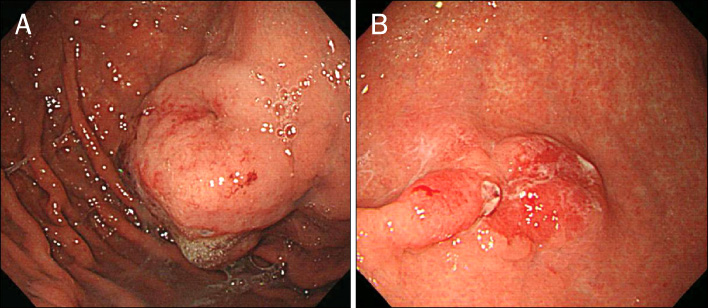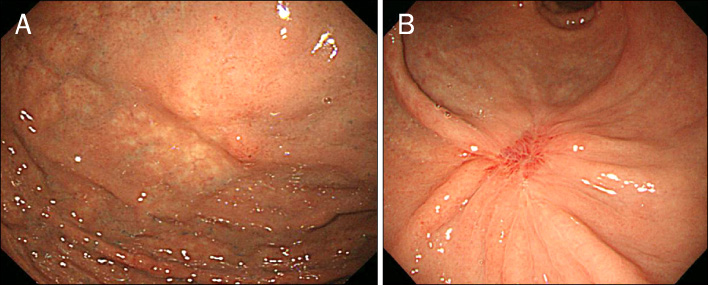Korean J Gastroenterol.
2012 May;59(5):377-381. 10.4166/kjg.2012.59.5.377.
A Case of Synchronous Early Gastric Cancer and Diffuse Large B Cell Lymphoma Treated with Endoscopic Submucosal Dissection and Chemotherapy
- Affiliations
-
- 1Department of Internal Medicine, Kyung Hee University College of Medicine, Seoul, Korea. jyjang@khu.ac.kr
- KMID: 1792838
- DOI: http://doi.org/10.4166/kjg.2012.59.5.377
Abstract
- Among malignant tumors of the stomach, adenocarcinoma takes up about 95% and the remaining are mostly lymphomas, being less than 5%. The majority of lymphomas are B cell lymphomas, and the most common types are low-grade B cell lymphoma of mucosa-associated lymphoid tissue and diffuse large B cell lymphoma (DLBL). The synchronous occurrence of adenocarcinoma and lymphoma in the stomach is being reported rarely. Especially the concurrence of adenocarcinoma and DLBL is very scarce and less than 10 cases have been reported inside and outside this country. In the past, the general treatment for cases of concurrence of adenocarcinoma and DLBL when surgery is possible according to cancer stages was gastrectomy, followed by single or combined chemotherapy and radiation treatment. However, when considering that most cases of concurrent adenocarcinoma were early gastric cancer which is limited to the mucosa, endoscopic submucosal dissection (ESD) can become an alternative treatment method for gastrectomy. We report the experience with chemotherapy and ESD done together instead of surgery, in patients concurrently diagnosed with early gastric cancer and gastric lymphoma.
MeSH Terms
Figure
Reference
-
1. Wotherspoon AC, Isaacson PG. Synchronous adenocarcinoma and low grade B-cell lymphoma of mucosa associated lymphoid tissue (MALT) of the stomach. Histopathology. 1995. 27:325–331.2. Hamaloglu E, Topaloglu S, Ozdemir A, Ozenc A. Synchronous and metachronous occurrence of gastric adenocarcinoma and gastric lymphoma: A review of the literature. World J Gastroenterol. 2006. 12:3564–3574.3. Nakamura S, Aoyagi K, Iwanaga S, Yao T, Tsuneyoshi M, Fujishima M. Synchronous and metachronous primary gastric lymphoma and adenocarcinoma: a clinicopathological study of 12 patients. Cancer. 1997. 79:1077–1085.4. Min BH, Choi KD, Im JP, et al. A case of synchronous early gastric cancer and low-grade MALT lymphoma. Korean J Gastrointest Endosc. 2002. 25:203–207.5. Jo JY, Jung HY, Choi KD, et al. Development of early gastric cancer 38 months after the complete remission of helicobacter pylori associated gastric MALT lymphoma. Korean J Gastrointest Endosc. 2006. 33:226–229.6. Seo DB, Kwon KS, Park HS, et al. Metachronous gastric MALT lymphoma and early gastric cancer: a case report. Korean J Gastroenterol. 2007. 49:245–250.7. Loffeld RJ, Willems I, Flendrig JA, Arends JW. Helicobacter pylori and gastric carcinoma. Histopathology. 1990. 17:537–541.8. Parsonnet J, Hansen S, Rodriguez L, et al. Helicobacter pylori infection and gastric lymphoma. N Engl J Med. 1994. 330:1267–1271.9. Correa P. Human gastric carcinogenesis: a multistep and multifactorial process--First American Cancer Society Award Lecture on Cancer Epidemiology and Prevention. Cancer Res. 1992. 52:6735–6740.10. Cammarota G, Gasbarrini G. Helicobacter pylori infection and autoimmune pathogenesis of gastric neoplasias. Gut. 2000. 46:295.11. Griffiths AP, Wyatt J, Jack AS, Dixon MF. Lymphocytic gastritis, gastric adenocarcinoma, and primary gastric lymphoma. J Clin Pathol. 1994. 47:1123–1124.12. Wotherspoon AC, Doglioni C, Diss TC, et al. Regression of primary low-grade B-cell gastric lymphoma of mucosa-associated lymphoid tissue type after eradication of Helicobacter pylori. Lancet. 1993. 342:575–577.13. Raderer M, Valencak J, Osterreicher C, et al. Chemotherapy for the treatment of patients with primary high grade gastric B-cell lymphoma of modified Ann Arbor Stages IE and IIE. Cancer. 2000. 88:1979–1985.14. Liu HT, Hsu C, Chen CL, et al. Chemotherapy alone versus surgery followed by chemotherapy for stage I/IIE large-cell lymphoma of the stomach. Am J Hematol. 2000. 64:175–179.15. Phan J, Mazloom A, Jeffrey Medeiros L, et al. Benefit of consolidative radiation therapy in patients with diffuse large B-cell lymphoma treated with R-CHOP chemotherapy. J Clin Oncol. 2010. 28:4170–4176.16. Isomoto H, Shikuwa S, Yamaguchi N, et al. Endoscopic submucosal dissection for early gastric cancer: a large-scale feasibility study. Gut. 2009. 58:331–336.17. Morgner A, Miehlke S, Stolte M, et al. Development of early gastric cancer 4 and 5 years after complete remission of Helicobacter pylori associated gastric low grade marginal zone B cell lymphoma of MALT type. World J Gastroenterol. 2001. 7:248–253.
- Full Text Links
- Actions
-
Cited
- CITED
-
- Close
- Share
- Similar articles
-
- A Case of Advanced Gastric Adenocarcinoma with Synchronous Gastric Diffuse Large B Cell Lymphoma
- Successful Endoscopic Resection of Gastric Mucosa-Associated Lymphoid Tissue Lymphoma Unresponsive to Helicobacter pylori Eradication Therapy
- A Case of Synchronous Double Primary Cancer of Gastric Adenocarcinoma and Diffuse Large B Cell Lymphoma
- Case of Synchronous Primary Gastric Diffuse Large B-Cell Lymphoma and Hepatocellular Carcinoma
- Endoscopic Submucosal Dissection in the Treatment of Patients With Papillary Early Gastric Cancer





